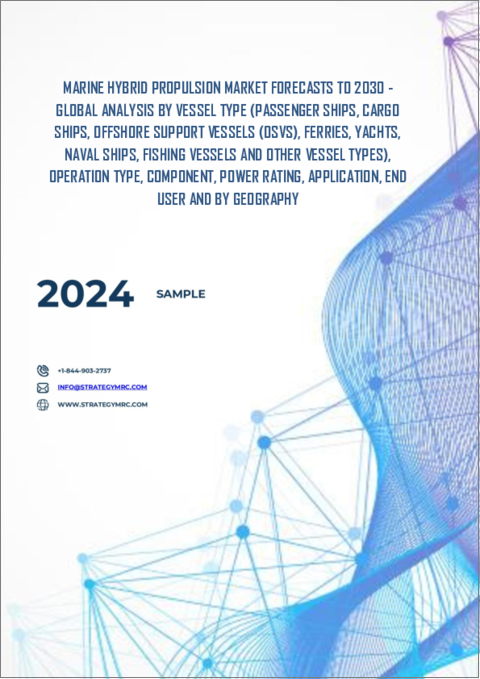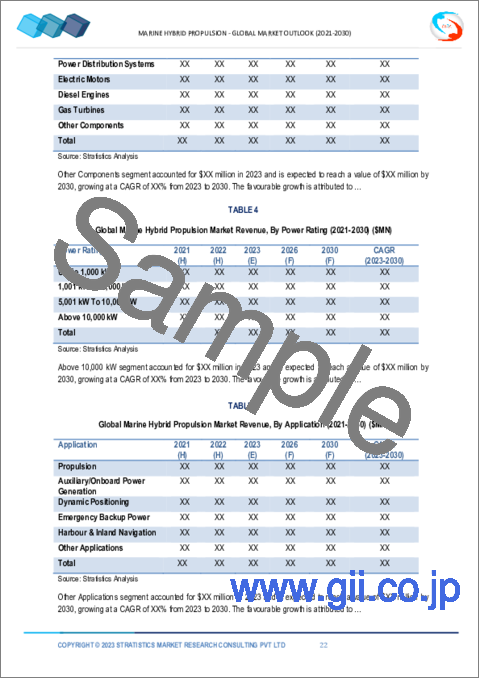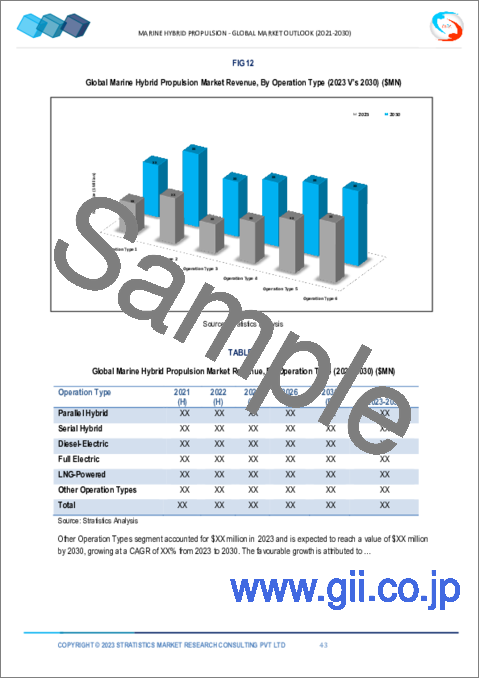|
|
市場調査レポート
商品コード
1438136
船舶用ハイブリッド推進市場の2030年までの予測:船舶タイプ別、作業タイプ別、コンポーネント別、定格出力別、用途別、エンドユーザー別、地域別の世界分析Marine Hybrid Propulsion Market Forecasts to 2030 - Global Analysis By Vessel Type, Operation Type, Component, Power Rating, Application, End User and By Geography |
||||||
カスタマイズ可能
|
|||||||
| 船舶用ハイブリッド推進市場の2030年までの予測:船舶タイプ別、作業タイプ別、コンポーネント別、定格出力別、用途別、エンドユーザー別、地域別の世界分析 |
|
出版日: 2024年02月02日
発行: Stratistics Market Research Consulting
ページ情報: 英文 200+ Pages
納期: 2~3営業日
|
全表示
- 概要
- 図表
- 目次
Stratistics MRCによると、世界の船舶用ハイブリッド推進市場は2023年に29億2,000万米ドルを占め、予測期間中のCAGRは9.2%で成長し、2030年には32億5,000万米ドルに達する見込みです。
船舶用ハイブリッド推進は、従来の内燃機関と電気推進システムを組み合わせたもので、海上運航における燃料効率を最適化し、環境への影響を低減します。この技術は、ディーゼルエンジンを電気モーターやエネルギー貯蔵ソリューションとシームレスに統合し、船舶がどちらかの動力源または両方の組み合わせで運航できるようにします。ハイブリッドアプローチは、全体的な燃費を向上させ、排出量を削減し、多様な航行条件への柔軟性を提供します。
国際クリーン輸送協議会(ICCT)の報告書によると、コンテナ船にハイブリッド推進システムを搭載すれば、燃料消費を10~20%削減できます。
再生可能エネルギー統合への関心の高まり
海運業界における環境持続可能性への取り組みの高まりが、再生可能エネルギー統合への関心の高まりを後押ししています。厳しい排出規制と、よりクリーンなエネルギー源への世界の後押しが、ハイブリッドシステムの採用を後押しし、船舶が太陽光や風力発電のような再生可能エネルギーを取り入れることを可能にしています。この動向は、より環境に優しいソリューションを追求する業界の姿勢と一致し、燃料効率を促進し、環境への影響を低減します。再生可能エネルギーの統合は、気候変動を緩和するための海事部門の連帯責任に対応し、海洋推進への持続可能で環境に優しいアプローチを促進します。
インフラの限界
インフラの限界には、バッテリー駆動式船舶向けの充電ステーションがまばらにしかないことや、異なるハイブリッドシステム用の標準化されたインフラがないことが含まれます。充電オプションが限られているため、特に十分なサポートがない地域では、潜在的な採用者の意欲をそぐ可能性があります。このため、業界は世界的に包括的で利用しやすい充電インフラを確立するという課題に直面しており、市場成長の妨げとなっています。
技術の進歩
船舶用ハイブリッド推進における技術の進歩には、改良されたバッテリー技術、高度な制御システム、効率的なエネルギー管理などがあります。これらの技術革新は、システムの信頼性を高め、配電を最適化し、電源間のシームレスな移行を可能にし、最適な性能を確保します。人工知能(AI)と機械学習の統合は、運用効率をさらに向上させます。これらの進歩は、燃料消費を削減し、船舶の操縦性を高め、排出ガスを低減し、厳しい環境規制と整合します。その結果、最先端の船舶用ハイブリッド推進技術に対するニーズの高まりが市場を牽引しています。
重量とスペースの制約
船舶用ハイブリッド推進における重量とスペースの制約は、バッテリーなどの追加コンポーネントを搭載する必要性から生じます。電気モードにとって重要な大型バッテリーバンクは、その重量とスペース要件のために課題をもたらす可能性があります。エネルギー貯蔵容量、重量、利用可能なスペースの間のトレードオフが障害となり、ハイブリッドシステムの適用可能性が制限され、特に特定の船舶カテゴリーにおいて、市場浸透の妨げとなる可能性があります。
COVID-19の影響
COVID-19の流行は市場に大きな影響を与え、製造、サプライチェーン、プロジェクトのタイムラインに混乱を引き起こしています。ロックダウンや渡航制限が生産と設置プロセスを妨げ、ハイブリッド推進システムの配備の遅れにつながっています。さらに、経済の不確実性と世界貿易の縮小は、海事産業における投資決定に影響を及ぼしています。こうした課題にもかかわらず、海運業界は持続可能なソリューションへの関心の高まりとともに回復力を示しており、海運業界が回復を目指し、進化する市場の需要に適応していく中で、船舶用ハイブリッド推進技術への継続的な関心を後押ししています。
予測期間中、旅客船セグメントが最大となる見込み
旅客船セグメントは、環境の持続可能性と旅客体験の向上という二重の焦点により、有利な成長を遂げると推定されます。旅客船のハイブリッドシステムは、燃料効率を高め、排出ガスを削減し、より静かでスムーズな体験を提供します。港湾業務のための電気専用モードを含む先進技術は、よりクリーンで楽しい旅に貢献します。環境に優しい旅行への需要が高まる中、旅客船への船舶用ハイブリッド推進の採用は、規制要件と持続可能で快適な海上輸送ソリューションへの嗜好の高まりの両方に合致しています。
非常用バックアップ電源セグメントは予測期間中に最も高いCAGRが見込まれる
非常用バックアップ電源セグメントは、予測期間中に最も高いCAGR成長が見込まれます。非常用バックアップ電源用途では、船舶用ハイブリッド推進が重要なライフラインを提供し、停電時や緊急時に船舶が必要な機能を維持できるようにします。電源間をシームレスに切り替える能力により、信頼性の高いバックアップ電源が提供されます。これにより、船舶の安全性、操縦性、救助活動や悪条件下での航行などの重要な状況に対応する能力が向上します。このシステムにより、船舶の信頼性が高まり、不測の課題にもタイムリーかつ効率的に対処できるようになります。
最大のシェアを占める地域:
アジア太平洋地域は、環境規制の増加と燃費効率の高いソリューションへの需要の急増により、予測期間中最大の市場シェアを占めると予測されます。中国、日本、韓国などの国々が、海運セクターにおけるハイブリッド推進システムの採用を主導しています。この地域は持続可能な海運に重点を置いており、技術の進歩や政府の奨励策と相まって市場拡大を後押ししています。環境への影響に対する意識の高まりと海事産業の成長は、ハイブリッド推進技術の広範な受け入れに貢献しており、アジア太平洋地域を世界の船舶用ハイブリッド推進市場の主要プレーヤーとして位置づけています。
CAGRが最も高い地域:
予測期間中、欧州のCAGRが最も高いと予測されます。欧州の船舶用ハイブリッド推進器市場は、同地域が持続可能な海事慣行を優先していることから盛んになっています。厳しい排出規制と環境意識が、ノルウェー、ドイツ、オランダなどの国々でハイブリッド推進システムの採用を促進しています。政府の奨励策と堅調な海事産業は、カーボンフットプリントの削減と燃料効率の向上に重点を置き、市場の成長に貢献しています。
無料のカスタマイズサービス:
本レポートをご購読のお客様には、以下の無料カスタマイズオプションのいずれかをご利用いただけます:
- 企業プロファイル
- 追加市場プレイヤーの包括的プロファイリング(3社まで)
- 主要企業のSWOT分析(3社まで)
- 地域セグメンテーション
- 顧客の関心に応じた主要国の市場推計・予測・CAGR(注:フィージビリティチェックによる)
- 競合ベンチマーキング
- 製品ポートフォリオ、地理的プレゼンス、戦略的提携に基づく主要企業のベンチマーキング
目次
第1章 エグゼクティブサマリー
第2章 序文
- 概要
- ステークホルダー
- 調査範囲
- 調査手法
- データマイニング
- データ分析
- データ検証
- 調査アプローチ
- 調査ソース
- 1次調査ソース
- 2次調査ソース
- 前提条件
第3章 市場動向分析
- 促進要因
- 抑制要因
- 機会
- 脅威
- アプリケーション分析
- エンドユーザー分析
- 新興市場
- 新型コロナウイルス感染症(COVID-19)の影響
第4章 ポーターのファイブフォース分析
- 供給企業の交渉力
- 買い手の交渉力
- 代替品の脅威
- 新規参入業者の脅威
- 競争企業間の敵対関係
第5章 世界の船舶用ハイブリッド推進市場:船舶タイプ別
- 旅客船
- 貨物船
- オフショア支援船(OSV)
- フェリー
- ヨット
- 海軍艦艇
- 漁船
- その他
第6章 世界の船舶用ハイブリッド推進市場:作業タイプ別
- パラレルハイブリッド
- シリアルハイブリッド
- ディーゼル電気
- 全電気
- LNG燃料
- その他
第7章 世界の船舶用ハイブリッド推進市場:コンポーネント別
- 電池システム
- 配電システム
- 電気モーター
- ディーゼルエンジン
- ガスタービン
- その他
第8章 世界の船舶用ハイブリッド推進市場:定格出力別
- 1,000kW以下
- 1,001kW~5,000kW
- 5,001kW~10,000kW
- 10,000kW超
第9章 世界の船舶用ハイブリッド推進市場:用途別
- 推進
- 補助/オンボード発電
- 動的位置決め
- 緊急時のバックアップ電源
- 港湾・陸航行
- その他
第10章 世界の船舶用ハイブリッド推進市場:エンドユーザー別
- 商業
- 防衛
第11章 世界の船舶用ハイブリッド推進市場:地域別
- 北米
- 米国
- カナダ
- メキシコ
- 欧州
- ドイツ
- 英国
- イタリア
- フランス
- スペイン
- その他欧州
- アジア太平洋地域
- 日本
- 中国
- インド
- オーストラリア
- ニュージーランド
- 韓国
- その他アジア太平洋地域
- 南米
- アルゼンチン
- ブラジル
- チリ
- その他南米
- 中東とアフリカ
- サウジアラビア
- アラブ首長国連邦
- カタール
- 南アフリカ
- その他中東とアフリカ
第12章 主な発展
- 契約、パートナーシップ、コラボレーション、合弁事業
- 買収と合併
- 新製品の発売
- 事業拡大
- その他の主要戦略
第13章 企業プロファイル
- ABB Group
- Siemens AG
- Wartsila Corporation
- Rolls-Royce Holdings PLC
- General Electric Company
- Schottel GmbH
- MAN Energy Solutions SE
- Caterpillar Inc.
- Volvo Penta
- Torqeedo GmbH
- Hyundai Heavy Industries Limited
- Baltic Workboats AS
- EST-Floattech
- Thrustmaster of Texas Inc.
- Danfoss Power Solutions
- Cummins Inc.
- Mercury Marine
- Yanmar Limited
- Bosch Rexroth AG
- Kongsberg Maritime AS
List of Tables
- Table 1 Global Marine Hybrid Propulsion Market Outlook, By Region (2021-2030) ($MN)
- Table 2 Global Marine Hybrid Propulsion Market Outlook, By Vessel Type (2021-2030) ($MN)
- Table 3 Global Marine Hybrid Propulsion Market Outlook, By Passenger Ships (2021-2030) ($MN)
- Table 4 Global Marine Hybrid Propulsion Market Outlook, By Cargo Ships (2021-2030) ($MN)
- Table 5 Global Marine Hybrid Propulsion Market Outlook, By Offshore Support Vessels (OSVs) (2021-2030) ($MN)
- Table 6 Global Marine Hybrid Propulsion Market Outlook, By Ferries (2021-2030) ($MN)
- Table 7 Global Marine Hybrid Propulsion Market Outlook, By Yachts (2021-2030) ($MN)
- Table 8 Global Marine Hybrid Propulsion Market Outlook, By Naval Ships (2021-2030) ($MN)
- Table 9 Global Marine Hybrid Propulsion Market Outlook, By Fishing Vessels (2021-2030) ($MN)
- Table 10 Global Marine Hybrid Propulsion Market Outlook, By Other Vessel Types (2021-2030) ($MN)
- Table 11 Global Marine Hybrid Propulsion Market Outlook, By Operation Type (2021-2030) ($MN)
- Table 12 Global Marine Hybrid Propulsion Market Outlook, By Parallel Hybrid (2021-2030) ($MN)
- Table 13 Global Marine Hybrid Propulsion Market Outlook, By Serial Hybrid (2021-2030) ($MN)
- Table 14 Global Marine Hybrid Propulsion Market Outlook, By Diesel-Electric (2021-2030) ($MN)
- Table 15 Global Marine Hybrid Propulsion Market Outlook, By Full Electric (2021-2030) ($MN)
- Table 16 Global Marine Hybrid Propulsion Market Outlook, By LNG-Powered (2021-2030) ($MN)
- Table 17 Global Marine Hybrid Propulsion Market Outlook, By Other Operation Types (2021-2030) ($MN)
- Table 18 Global Marine Hybrid Propulsion Market Outlook, By Component (2021-2030) ($MN)
- Table 19 Global Marine Hybrid Propulsion Market Outlook, By Battery Systems (2021-2030) ($MN)
- Table 20 Global Marine Hybrid Propulsion Market Outlook, By Power Distribution Systems (2021-2030) ($MN)
- Table 21 Global Marine Hybrid Propulsion Market Outlook, By Electric Motors (2021-2030) ($MN)
- Table 22 Global Marine Hybrid Propulsion Market Outlook, By Diesel Engines (2021-2030) ($MN)
- Table 23 Global Marine Hybrid Propulsion Market Outlook, By Gas Turbines (2021-2030) ($MN)
- Table 24 Global Marine Hybrid Propulsion Market Outlook, By Other Components (2021-2030) ($MN)
- Table 25 Global Marine Hybrid Propulsion Market Outlook, By Power Rating (2021-2030) ($MN)
- Table 26 Global Marine Hybrid Propulsion Market Outlook, By Up To 1,000 kW (2021-2030) ($MN)
- Table 27 Global Marine Hybrid Propulsion Market Outlook, By 1,001 kW To 5,000 kW (2021-2030) ($MN)
- Table 28 Global Marine Hybrid Propulsion Market Outlook, By 5,001 kW To 10,000 kW (2021-2030) ($MN)
- Table 29 Global Marine Hybrid Propulsion Market Outlook, By Above 10,000 kW (2021-2030) ($MN)
- Table 30 Global Marine Hybrid Propulsion Market Outlook, By Application (2021-2030) ($MN)
- Table 31 Global Marine Hybrid Propulsion Market Outlook, By Propulsion (2021-2030) ($MN)
- Table 32 Global Marine Hybrid Propulsion Market Outlook, By Auxiliary/Onboard Power Generation (2021-2030) ($MN)
- Table 33 Global Marine Hybrid Propulsion Market Outlook, By Dynamic Positioning (2021-2030) ($MN)
- Table 34 Global Marine Hybrid Propulsion Market Outlook, By Emergency Backup Power (2021-2030) ($MN)
- Table 35 Global Marine Hybrid Propulsion Market Outlook, By Harbour & Inland Navigation (2021-2030) ($MN)
- Table 36 Global Marine Hybrid Propulsion Market Outlook, By Other Applications (2021-2030) ($MN)
- Table 37 Global Marine Hybrid Propulsion Market Outlook, By End User (2021-2030) ($MN)
- Table 38 Global Marine Hybrid Propulsion Market Outlook, By Commercial (2021-2030) ($MN)
- Table 39 Global Marine Hybrid Propulsion Market Outlook, By Defense (2021-2030) ($MN)
Note: Tables for North America, Europe, APAC, South America, and Middle East & Africa Regions are also represented in the same manner as above.
According to Stratistics MRC, the Global Marine Hybrid Propulsion Market is accounted for $2.92 billion in 2023 and is expected to reach $3.25 billion by 2030 growing at a CAGR of 9.2% during the forecast period. Marine hybrid propulsion combines traditional internal combustion engines with electric propulsion systems, optimizing fuel efficiency and reducing environmental impact in maritime operations. This technology seamlessly integrates diesel engines with electric motors and energy storage solutions, allowing vessels to operate on either power source or a combination of both. The hybrid approach enhances overall fuel economy, lowers emissions, and provides flexibility for diverse navigation conditions.
According to a report by the International Council on Clean Transportation (ICCT) a hybrid propulsion system installed on a container ship could reduce fuel consumption by 10-20%.
Market Dynamics:
Driver:
Growing interest in renewable energy integration
The maritime industry's increasing commitment to environmental sustainability fuels the growing interest in renewable energy integration. Stringent emissions regulations and a global push toward cleaner energy sources propel the adoption of hybrid systems, enabling ships to incorporate renewable sources like solar and wind power. This trend aligns with the industry's pursuit of greener solutions, promoting fuel efficiency and reducing environmental impact. The integration of renewable energy addresses the maritime sector's collective responsibility to mitigate climate change, fostering a sustainable and eco-friendly approach to marine propulsion.
Restraint:
Infrastructure limitations
Infrastructure limitations include the sparse availability of charging stations for battery-powered vessels and the lack of standardized infrastructure for different hybrid systems. Limited charging options may discourage potential adopters, particularly in regions without adequate support. This hinders market growth as the industry faces challenges in establishing a comprehensive and accessible charging infrastructure globally.
Opportunity:
Technological advancements
Technological advancements in marine hybrid propulsion include improved battery technologies, advanced control systems, and efficient energy management. These innovations enhance system reliability, optimize power distribution, and enable seamless transitions between power sources, ensuring optimal performance. The integration of artificial intelligence (AI) and machine learning further refines operational efficiency. These advancements reduce fuel consumption, enhance vessel manoeuvrability and lower emissions, aligning with stringent environmental regulations. As a result, the market is driven by the growing need for cutting-edge marine hybrid propulsion technologies.
Threat:
Weight and space constraints
Weight & space constraints in marine hybrid propulsion arise from the need to accommodate additional components such as batteries. Large battery banks, crucial for electric modes, can pose challenges due to their weight and space requirements. The associated trade-offs between energy storage capacities, weight, and available space present obstacles, limiting the applicability of hybrid systems and potentially hindering their market penetration, especially in certain vessel categories.
Covid-19 Impact
The covid-19 pandemic has significantly impacted the market, causing disruptions in manufacturing, supply chain, and project timelines. Lockdowns and travel restrictions have hampered production and installation processes, leading to delays in hybrid propulsion system deployments. Additionally, economic uncertainties and reduced global trade have affected investment decisions in the maritime industry. Despite these challenges, the industry has shown resilience with a growing focus on sustainable solutions, driving continued interest in marine hybrid propulsion technologies as the sector aims to recover and adapt to evolving market demands.
The passenger ships segment is expected to be the largest during the forecast period
The passenger ships segment is estimated to have a lucrative growth, due to its dual focus on environmental sustainability and enhanced passenger experience. Hybrid systems in passenger vessels, enhance fuel efficiency, reduce emissions, and offer a quieter and smoother experience. Advanced technologies, including electric-only modes for port operations, contribute to a cleaner and more enjoyable journey. As the demand for eco-friendly travel rises, the adoption of Marine Hybrid Propulsion in passenger ships aligns with both regulatory requirements and the growing preference for sustainable and comfortable maritime transportation solutions.
The emergency backup power segment is expected to have the highest CAGR during the forecast period
The emergency backup power segment is anticipated to witness the highest CAGR growth during the forecast period. In emergency backup power applications, marine hybrid propulsion offers a crucial lifeline, ensuring vessels maintain essential functions during power outages or emergencies. The ability to seamlessly switch between power sources, provides reliable backup power. This enhances vessel safety, manoeuvrability, and the ability to respond to critical situations, such as rescue missions or navigation in adverse conditions. This system makes them more dependable and capable of addressing unforeseen challenges in a timely and efficient manner.
Region with largest share:
Asia Pacific is projected to hold the largest market share during the forecast period owing to the increasing environmental regulations and a surge in demand for fuel-efficient solutions. Countries like China, Japan, and South Korea are leading the adoption of hybrid propulsion systems in the maritime sector. The region's focus on sustainable shipping, coupled with technological advancements and government incentives, propels market expansion. Rising awareness of environmental impact and a growing maritime industry contribute to the widespread acceptance of hybrid propulsion technologies, positioning the Asia-Pacific region as a key player in the global marine hybrid propulsion market.
Region with highest CAGR:
Europe is projected to have the highest CAGR over the forecast period. The marine hybrid propulsion market in Europe is flourishing as the region prioritizes sustainable maritime practices. Stringent emission regulations and environmental consciousness drive the adoption of hybrid propulsion systems in countries like Norway, Germany, and the Netherlands. Government incentives and a robust maritime industry contribute to the market's growth, with a focus on reducing carbon footprint and enhancing fuel efficiency.
Key players in the market
Some of the key players profiled in the Marine Hybrid Propulsion Market include ABB Group, Siemens AG, Wartsila Corporation, Rolls-Royce Holdings PLC, General Electric Company, Schottel GmbH, MAN Energy Solutions SE, Caterpillar Inc., Volvo Penta, Torqeedo GmbH, Hyundai Heavy Industries Limited, Baltic Workboats AS, EST-Floattech, Thrustmaster of Texas Inc., Danfoss Power Solutions, Cummins Inc., Mercury Marine, Yanmar Limited, Bosch Rexroth AG and Kongsberg Maritime AS.
Key Developments:
In June 2023, GE showcased electric drive power and propulsion and gas turbine solutions, proven to meet the most demanding needs of world navies, at MADEX International Marine Industrial Defense Exhibition, in Busan. GE Marine displayed its gas turbine features and benefits, while demonstrating total lifecycle cost advantages.
In May 2023, ABB introduced ABB Dynafin™, a new concept representing a revolutionary propulsion system breaking new ground for efficiency in the marine industry. ABB's combined extensive experience and expertise in the marine industry, along with its innovative heritage, is the driving forces behind this new concept.
Vessel Types Covered:
- Passenger Ships
- Cargo Ships
- Offshore Support Vessels (OSVs)
- Ferries
- Yachts
- Naval Ships
- Fishing Vessels
- Other Vessel Types
Operation Types Covered:
- Parallel Hybrid
- Serial Hybrid
- Diesel-Electric
- Full Electric
- LNG-Powered
- Other Operation Types
Components Covered:
- Battery Systems
- Power Distribution Systems
- Electric Motors
- Diesel Engines
- Gas Turbines
- Other Components
Power Ratings Covered:
- Up To 1,000 kW
- 1,001 kW To 5,000 kW
- 5,001 kW To 10,000 kW
- Above 10,000 kW
Applications Covered:
- Propulsion
- Auxiliary/Onboard Power Generation
- Dynamic Positioning
- Emergency Backup Power
- Harbour & Inland Navigation
- Other Applications
End Users Covered:
- Commercial
- Defense
Regions Covered:
- North America
- US
- Canada
- Mexico
- Europe
- Germany
- UK
- Italy
- France
- Spain
- Rest of Europe
- Asia Pacific
- Japan
- China
- India
- Australia
- New Zealand
- South Korea
- Rest of Asia Pacific
- South America
- Argentina
- Brazil
- Chile
- Rest of South America
- Middle East & Africa
- Saudi Arabia
- UAE
- Qatar
- South Africa
- Rest of Middle East & Africa
What our report offers:
- Market share assessments for the regional and country-level segments
- Strategic recommendations for the new entrants
- Covers Market data for the years 2021, 2022, 2023, 2026, and 2030
- Market Trends (Drivers, Constraints, Opportunities, Threats, Challenges, Investment Opportunities, and recommendations)
- Strategic recommendations in key business segments based on the market estimations
- Competitive landscaping mapping the key common trends
- Company profiling with detailed strategies, financials, and recent developments
- Supply chain trends mapping the latest technological advancements
Free Customization Offerings:
All the customers of this report will be entitled to receive one of the following free customization options:
- Company Profiling
- Comprehensive profiling of additional market players (up to 3)
- SWOT Analysis of key players (up to 3)
- Regional Segmentation
- Market estimations, Forecasts and CAGR of any prominent country as per the client's interest (Note: Depends on feasibility check)
- Competitive Benchmarking
- Benchmarking of key players based on product portfolio, geographical presence, and strategic alliances
Table of Contents
1 Executive Summary
2 Preface
- 2.1 Abstract
- 2.2 Stake Holders
- 2.3 Research Scope
- 2.4 Research Methodology
- 2.4.1 Data Mining
- 2.4.2 Data Analysis
- 2.4.3 Data Validation
- 2.4.4 Research Approach
- 2.5 Research Sources
- 2.5.1 Primary Research Sources
- 2.5.2 Secondary Research Sources
- 2.5.3 Assumptions
3 Market Trend Analysis
- 3.1 Introduction
- 3.2 Drivers
- 3.3 Restraints
- 3.4 Opportunities
- 3.5 Threats
- 3.6 Application Analysis
- 3.7 End User Analysis
- 3.8 Emerging Markets
- 3.9 Impact of Covid-19
4 Porters Five Force Analysis
- 4.1 Bargaining power of suppliers
- 4.2 Bargaining power of buyers
- 4.3 Threat of substitutes
- 4.4 Threat of new entrants
- 4.5 Competitive rivalry
5 Global Marine Hybrid Propulsion Market, By Vessel Type
- 5.1 Introduction
- 5.2 Passenger Ships
- 5.3 Cargo Ships
- 5.4 Offshore Support Vessels (OSVs)
- 5.5 Ferries
- 5.6 Yachts
- 5.7 Naval Ships
- 5.8 Fishing Vessels
- 5.9 Other Vessel Types
6 Global Marine Hybrid Propulsion Market, By Operation Type
- 6.1 Introduction
- 6.2 Parallel Hybrid
- 6.3 Serial Hybrid
- 6.4 Diesel-Electric
- 6.5 Full Electric
- 6.6 LNG-Powered
- 6.7 Other Operation Types
7 Global Marine Hybrid Propulsion Market, By Component
- 7.1 Introduction
- 7.2 Battery Systems
- 7.3 Power Distribution Systems
- 7.4 Electric Motors
- 7.5 Diesel Engines
- 7.6 Gas Turbines
- 7.7 Other Components
8 Global Marine Hybrid Propulsion Market, By Power Rating
- 8.1 Introduction
- 8.2 Up To 1,000 kW
- 8.3 1,001 kW To 5,000 kW
- 8.4 5,001 kW To 10,000 kW
- 8.5 Above 10,000 kW
9 Global Marine Hybrid Propulsion Market, By Application
- 9.1 Introduction
- 9.2 Propulsion
- 9.3 Auxiliary/Onboard Power Generation
- 9.4 Dynamic Positioning
- 9.5 Emergency Backup Power
- 9.6 Harbour & Inland Navigation
- 9.7 Other Applications
10 Global Marine Hybrid Propulsion Market, By End User
- 10.1 Introduction
- 10.2 Commercial
- 10.3 Defense
11 Global Marine Hybrid Propulsion Market, By Geography
- 11.1 Introduction
- 11.2 North America
- 11.2.1 US
- 11.2.2 Canada
- 11.2.3 Mexico
- 11.3 Europe
- 11.3.1 Germany
- 11.3.2 UK
- 11.3.3 Italy
- 11.3.4 France
- 11.3.5 Spain
- 11.3.6 Rest of Europe
- 11.4 Asia Pacific
- 11.4.1 Japan
- 11.4.2 China
- 11.4.3 India
- 11.4.4 Australia
- 11.4.5 New Zealand
- 11.4.6 South Korea
- 11.4.7 Rest of Asia Pacific
- 11.5 South America
- 11.5.1 Argentina
- 11.5.2 Brazil
- 11.5.3 Chile
- 11.5.4 Rest of South America
- 11.6 Middle East & Africa
- 11.6.1 Saudi Arabia
- 11.6.2 UAE
- 11.6.3 Qatar
- 11.6.4 South Africa
- 11.6.5 Rest of Middle East & Africa
12 Key Developments
- 12.1 Agreements, Partnerships, Collaborations and Joint Ventures
- 12.2 Acquisitions & Mergers
- 12.3 New Product Launch
- 12.4 Expansions
- 12.5 Other Key Strategies
13 Company Profiling
- 13.1 ABB Group
- 13.2 Siemens AG
- 13.3 Wartsila Corporation
- 13.4 Rolls-Royce Holdings PLC
- 13.5 General Electric Company
- 13.6 Schottel GmbH
- 13.7 MAN Energy Solutions SE
- 13.8 Caterpillar Inc.
- 13.9 Volvo Penta
- 13.10 Torqeedo GmbH
- 13.11 Hyundai Heavy Industries Limited
- 13.12 Baltic Workboats AS
- 13.13 EST-Floattech
- 13.14 Thrustmaster of Texas Inc.
- 13.15 Danfoss Power Solutions
- 13.16 Cummins Inc.
- 13.17 Mercury Marine
- 13.18 Yanmar Limited
- 13.19 Bosch Rexroth AG
- 13.20 Kongsberg Maritime AS





